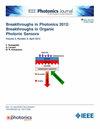High-Quality and Enhanced-Resolution Single-Pixel Imaging Based on Spiral Line Array Laser Source
IF 2.1
4区 工程技术
Q3 ENGINEERING, ELECTRICAL & ELECTRONIC
引用次数: 0
Abstract
Single-pixel imaging (SPI) is a novel computational imaging technique which combines illumination light fields and single-pixel detection values to reconstruct the image. Therefore, the generation method of the illumination light fields affects the imaging efficiency and quality. We propose a spiral line array laser source which can generate random illumination light fields without periodicity in the normalized second-order correlation function基于螺旋线阵列激光源的高质量、高分辨率单像素成像技术
单像素成像(SPI)是一种新颖的计算成像技术,它将照明光场和单像素检测值结合起来重建图像。因此,照明光场的生成方法会影响成像效率和质量。我们提出了一种螺旋线阵列激光源,它能产生随机照明光场,且归一化二阶相关函数 g(2) 没有周期性。它还具有较低的半最大值全宽(FWHM)。在数值模拟和实验中,我们采用了基于总变异算法的压缩传感来重建图像。我们证明,与现有的阵列激光光源(包括六边形和费马螺旋阵列)相比,新型阵列能够获得质量和分辨率更高的图像。结合光纤激光器和电光相位调制器,它有望实现光场的高速调制和高发射功率。因此,这种方法在远程目标探测和识别方面具有很大的应用潜力。
本文章由计算机程序翻译,如有差异,请以英文原文为准。
求助全文
约1分钟内获得全文
求助全文
来源期刊

IEEE Photonics Journal
ENGINEERING, ELECTRICAL & ELECTRONIC-OPTICS
CiteScore
4.50
自引率
8.30%
发文量
489
审稿时长
1.4 months
期刊介绍:
Breakthroughs in the generation of light and in its control and utilization have given rise to the field of Photonics, a rapidly expanding area of science and technology with major technological and economic impact. Photonics integrates quantum electronics and optics to accelerate progress in the generation of novel photon sources and in their utilization in emerging applications at the micro and nano scales spanning from the far-infrared/THz to the x-ray region of the electromagnetic spectrum. IEEE Photonics Journal is an online-only journal dedicated to the rapid disclosure of top-quality peer-reviewed research at the forefront of all areas of photonics. Contributions addressing issues ranging from fundamental understanding to emerging technologies and applications are within the scope of the Journal. The Journal includes topics in: Photon sources from far infrared to X-rays, Photonics materials and engineered photonic structures, Integrated optics and optoelectronic, Ultrafast, attosecond, high field and short wavelength photonics, Biophotonics, including DNA photonics, Nanophotonics, Magnetophotonics, Fundamentals of light propagation and interaction; nonlinear effects, Optical data storage, Fiber optics and optical communications devices, systems, and technologies, Micro Opto Electro Mechanical Systems (MOEMS), Microwave photonics, Optical Sensors.
 求助内容:
求助内容: 应助结果提醒方式:
应助结果提醒方式:


